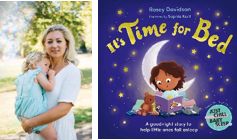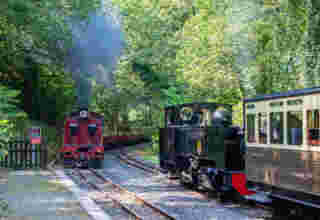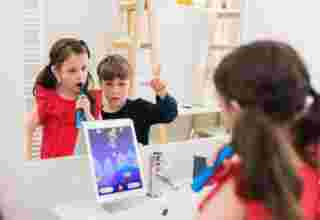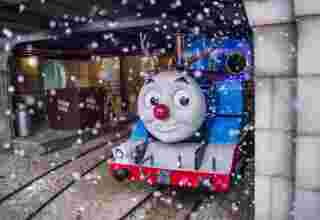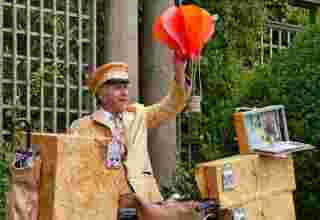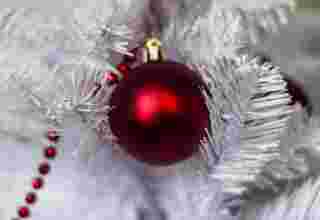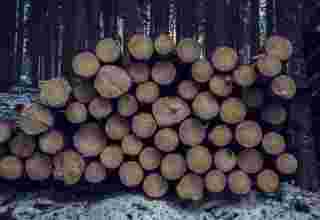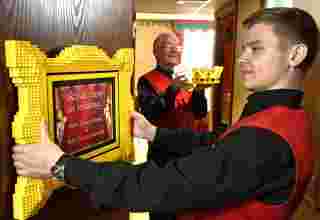“You may hear a voice inside.
And if that voice starts to whisper to follow the farthest star …
Moana, that voice inside is who you are.”
~ Gramma Tala, “Moana”

From Walt Disney Animation Studios comes “Moana,” a sweeping, CG-animated feature film about an adventurous teenager who sails out on a daring mission to save her people. “Moana is the 16-year-old daughter of the chief of Motunui,” says director Ron Clements. “She’s athletic, nimble, compassionate and incredibly smart. She has a never-say-die attitude and a profound connection to the ocean.”
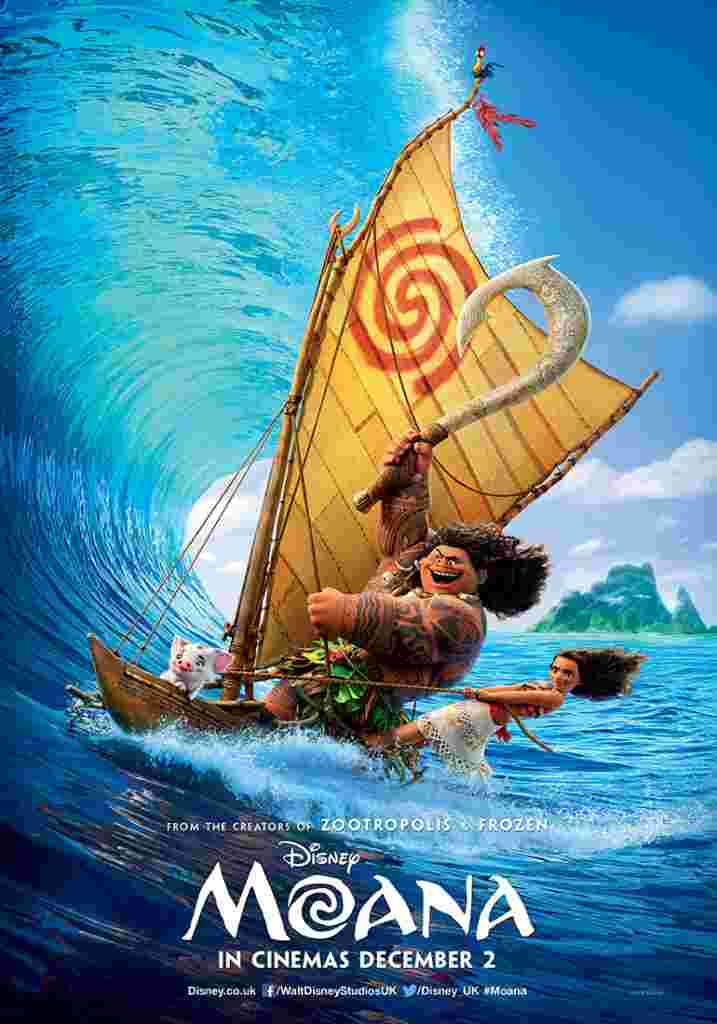
“So it’s troubling to her, to say the least, that her people don’t go beyond the reef surrounding their island,” adds director John Musker. “They stay within the confines of that reef, and Moana doesn’t really understand why.”
The story is inspired in part by the oral histories of the people and cultures of Oceania. Three thousand years ago, Polynesian voyagers, the greatest navigators in the world, voyaged across the vast Pacific, discovering thousands of islands. But then, according to scholars, for approximately a millennium, their voyages stopped – and no one knows exactly why. “Navigation is such a big part of Pacific culture,” says Musker. “The ancient Polynesians found their way across the seas without the use of modern instruments, using their knowledge of nature, the stars, the waves and the currents.”
Adds Clements, “We heard many times that the ocean doesn’t separate the islands, it connects them. Voyaging is a real source of pride for Pacific Islanders, a part of their identity. They were, and continue to be, some of the greatest explorers of all time. What they did was quite sophisticated, borderline miraculous.”
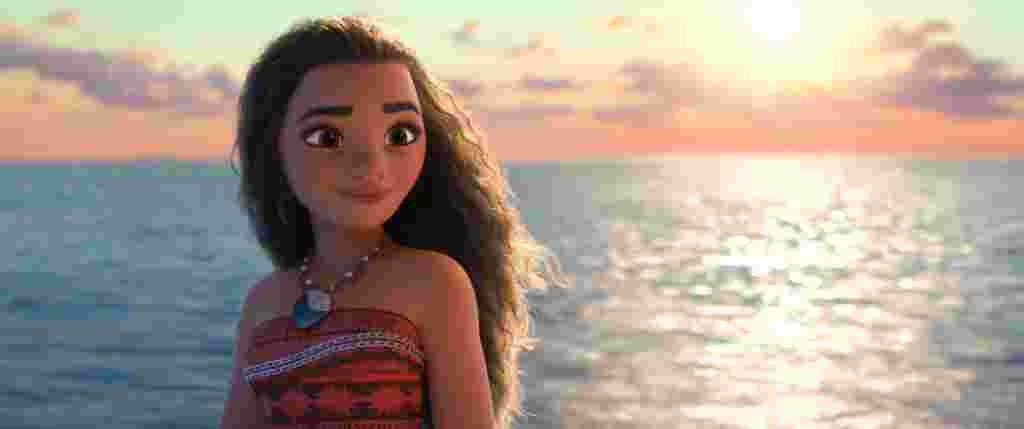
There are many theories, but no one is certain, about what may have led to this 1,000-year gap in exploration; this sparked the filmmakers’ imaginations. Says Musker, “In our story, our heroine, Moana, is at the heart of the rebirth of wayfinding.”
During her journey, Moana meets the mighty demigod Maui, a larger-than-life character who was inspired by multitudes of varied tales and legends about him throughout the Oceania region. Says Musker, “We were fascinated by the stories we read, the tales told to us by experts in the region. Maui was larger-than-life, a trickster and a shapeshifter. He could pull up whole islands from the sea with his fishhook; he had the power to slow down the sun. He is an incredible figure.”
Maui, who’s on his own journey of self-discovery, reluctantly guides Moana in her quest to become a master wayfinder and save her people. Together, they sail across the open ocean on an action-packed voyage, encountering enormous monsters and impossible odds, and along the way, Moana discovers the one thing she’s always sought: her own identity.
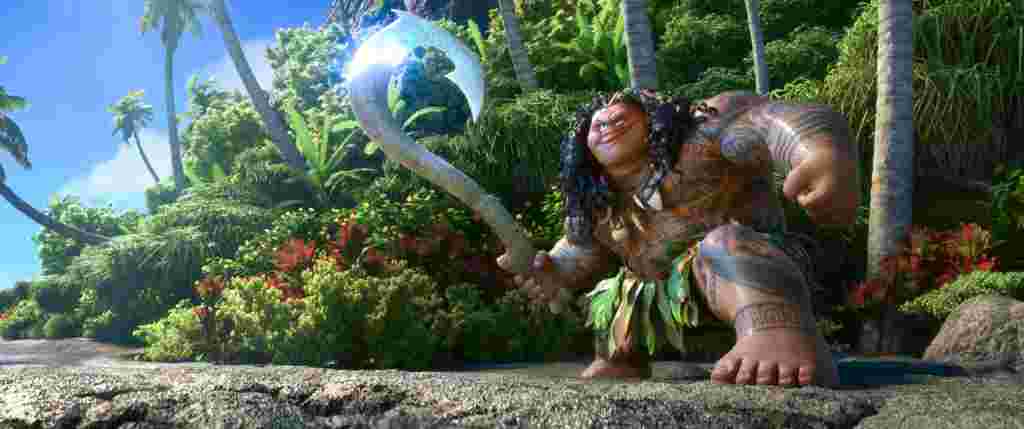
“It’s a story that takes place many, many years ago, but with a contemporary feel,” says producer Osnat Shurer. “Our hope as filmmakers has been to create a universal story that is also an homage to the beautiful people of the Pacific Islands who inspired us along this journey.”
Filmmakers cast newcomer Auli‘i Cravalho as the voice of Moana, and Dwayne Johnson (HBO’s “Ballers,” “Central Intelligence”) lends his voice to demigod Maui. The voice cast also includes Jemaine Clement (“The BFG,” “Despicable Me,” “Rio,” “Rio 2,” “What We Do in the Shadows,” Flight of the Conchords) as Tamatoa, a self-absorbed, 50-foot crab ; Rachel House (“Whale Rider,” “Hunt for Wilderpeople”) as Moana’s trusted Gramma Tala; Temuera Morrison (“Star Wars: Episode II – Attack of the Clones,” “Once Were Warriors,” “Six Days, Seven Nights”) as Moana’s no-nonsense father, Chief Tui; Alan Tudyk (“Zootopia,” “Wreck-It Ralph,” “Big Hero 6”) as the voice of dumb rooster Heihei; and Nicole Scherzinger (“Men in Black 3,” lead singer of The Pussycat Dolls) voices Moana’s playful and strong-willed mother, Sina.
Helmed by Clements and Musker, the directing team behind “The Little Mermaid,” “Aladdin” “The Princess & the Frog,” and produced by Shurer (“Lifted,” “One Man Band”), “Moana” features music from a diverse and dynamic team that includes Tony®-winner Lin-Manuel Miranda (Broadway’s Pulitzer Prize-winning and multiple Tony-winning “Hamilton,” Tony-winning “In the Heights”), Grammy®-winning composer Mark Mancina (“Speed,” “Tarzan” “The Lion King”) and Opetaia Foaʻi (founder and lead singer of the world music award-winning band Te Vaka).
Walt Disney Animation Studios’ 56th animated feature sails into U.S. theaters on Dec, 2nd 2016.
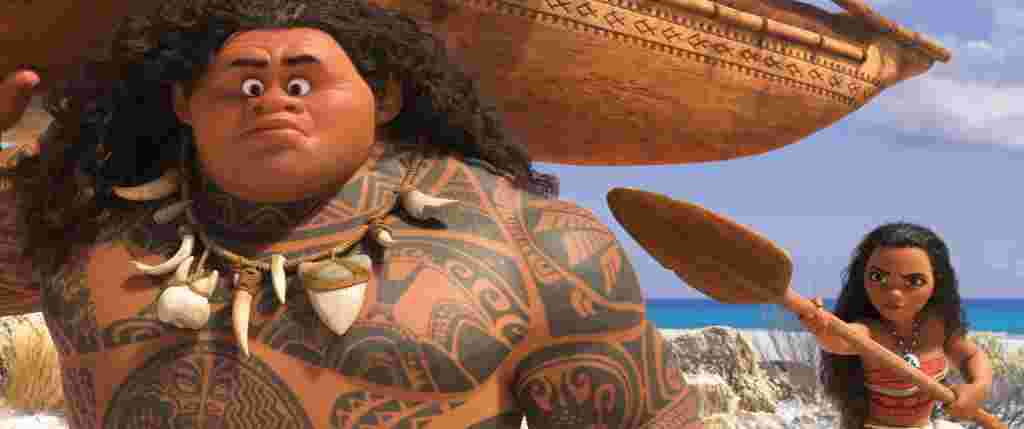
RESEARCH
Filmmakers Travel to Oceania and the Oceanic Story Trust is Formed
When first thinking of setting an animated feature in the beautiful Pacific Islands, directors Ron Clements and John Musker recalled from their youth beloved novels and paintings about the Pacific. But once they began exploring the incredible tales within Polynesian mythology a few years ago, the filmmakers realized they needed to dive much, much deeper. They knew they needed to go to the islands of the Pacific to see the places and meet the people in person. So Clements and Musker, along with a group of Disney Animation artists, traveled to the southern region of Oceania over the course of two fully loaded trips.
“We came away from these trips not only with ideas, images and inspirations for our story, but with an even stronger resolve that we wanted to make something that the people we met would enjoy,” says Musker. “We aren’t making a documentary, of course, it’s an animated feature. But our experiences infused our imaginations in a way we hadn’t anticipated.”
Clements, Musker and several members of the production team ventured first to Fiji, Samoa and Tahiti, and later to New Zealand. “We wanted to, as much as possible, avoid the ‘touristy’ things, to go deeper,” says Clements. “We wanted to meet people who grew up on islands; we wanted to listen and learn what makes these Pacific Island cultures so remarkable.”
The filmmakers were invited to take to the seas, coming as close as possible to voyaging like the early explorers who inspired them. “We sailed with a Fijian navigator aboard a camakau, which is a traditional Fijian sailing vessel,” says Musker. “We actually saw a 2,000-year-old camakau in the Fiji Museum and the design has changed very little in all those years. It’s impressive.”
The team was invited to explore Fiji’s Sigatoka Sand Dunes National Park with local archeologists, and visited the Fiji Museum, where experts showed them incredible artifacts, including boats and tools. They met with master tattooists, expert fisherman, and shared the local cuisine with the generous people they met. “We drank a lot of kava,” says Clements. “It’s a bitter-tasting drink made from the roots of a pepper tree.”
In Samoa, they saw black lava fields and met with local chiefs. On Savai‘i they were doused by the famous Alofaaga blowholes, and on Manono island they were invited to participate in a traditional kava ceremony. They canoed along the famous surf break of Teahupo‘o in Tahiti, and swam and hiked in areas that would later influence the look of the film. Filmmakers witnessed how tapa cloth is made and experienced performances of traditional dances.
Later, filmmakers, along with the trio behind the film’s music, Lin-Manuel Miranda, Mark Mancina and Opetaia Foa‘i, attended the Pasifika Festival in Auckland, New Zealand. “This was the first time we had our incredible ‘Moana’ musical team together—with each other and with the filmmakers,” says producer Osnat Shurer. “The festival was a wonderful opportunity to experience the variety and joy of the music and the dances of the many Pacific Island cultures.”
Among the many people they met, one meeting stood out, recalls Clements. “An elder on the island of Mo‘orea asked of us something so simple and so revealing: ‘For years, we have been swallowed by your culture,’ he said. ‘This one time, can you be swallowed by ours?’”
“This team was transformed,” says Shurer. “The research trips opened our eyes. To create our fictional story set 2,000 years ago, we knew we needed to invite the experts we met during the trips to be a part of the creation of the film. It was one thing to be inspired by the research trips, but we wanted to go further. We wanted their voices to influence the film—from the story, to the look of the environments, to the characters. Everything—from how Moana’s canoe looks and functions, to plants on the islands, to the material used in their clothing—was all deeply influenced by our advisors.”
Filmmakers ultimately assembled the Oceanic Story Trust that includes a team of experts—anthropologists, academics, educators, linguists, master navigators and cultural advisors—who collaborated with Disney’s creative team. “The Trust has deeply influenced the look and feel of this film,” says Shurer.
THE LINEUP
“Moana” Features Dynamic Characters and Top-Notch Voice Talent
Inspired by the people they encountered during their travels to the islands of the Pacific, filmmakers populated their story with a host of dynamic characters. A top-notch voice cast helps bring the characters to life.
Moana
Moana is an adventurous, tenacious and compassionate 16-year-old who is struggling to find her true self. While her father, Chief Tui, pressures her to follow in his footsteps and lead their island one day, Moana is drawn to the sea. The people of her village are forbidden to go beyond the safety of the reef, yet the open ocean seems to beckon Moana. “It doesn’t seem possible for her to fulfill her heart’s desire and still be true to her people and her culture,” says director Ron Clements. “She descended from navigators, but she doesn’t know it.”
When her island is threatened by a terrible darkness, Moana breaks the rules and sets sail on an epic adventure to save her people and find the answers she’s been searching for her whole life. Says director John Musker, “She is inspired to solve the problem of this world that has been haunting them and has made voyaging impossible. If she can face this problem that’s plagued them for a thousand years, perhaps voyaging could resume.”
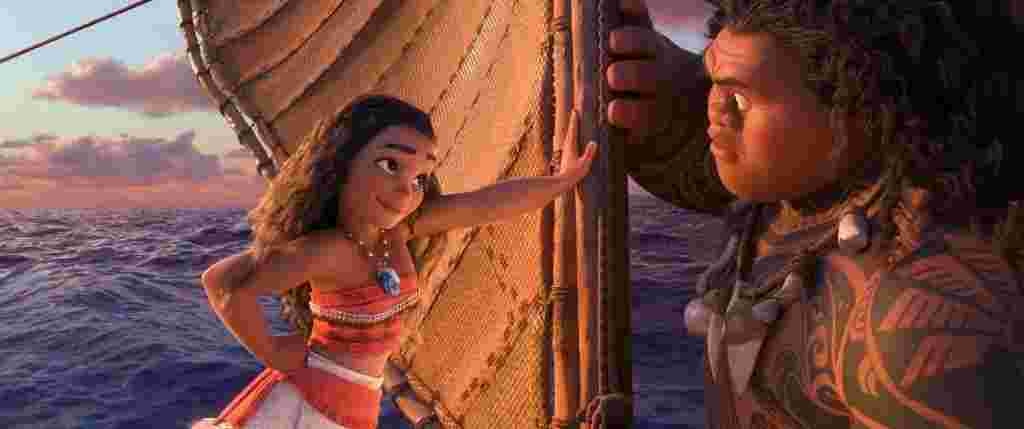
“She is a strong hero who sets out to retrieve what her people lost a long time ago,” says producer Osnat Shurer. “This isn’t a love story—it’s action, adventure, fun and drama. Moana wants to save the world—literally—even though she’s just about the only person who realizes it needs saving. She’s a powerful role model for today’s audiences.”
Newcomer Auli‘i Cravalho was called on to provide the voice of the tenacious teenager. “She has the spirit of Moana,” says Shurer. “We tease her and she teases us right back. There’s a fearlessness, but at the same time genuine warmth. She is a natural talent and a professional—but still a kid at heart.”
Maui
Maui is a demigod—half god, half mortal, all awesome. Charismatic and funny, he wields a magical fishhook that allows him to shapeshift into all kinds of animals and pull up islands from the sea. Maui was once considered the greatest hero in Oceania; his body is covered with tattoos of his extraordinary feats, including a mini-version of himself that acts as Maui’s conscience. “Maui is responsible for the trouble that threatens Moana’s people,” says Musker. “He’s paying a price for his actions and is somewhat of a lost hero—a shadow of his former self. Moana needs him to right his wrongs and restore what’s been lost.”
Embarking on an important journey of self-discovery alongside Moana, Maui brings his super strength—as well as his super-sized issues. “He has an all-encompassing drive to succeed that gets him into trouble,” says Clements. “But facing the reason behind it isn’t easy.”
Filmmakers called on Dwayne Johnson to provide the voice of Maui. “He’s very connected to his Samoan roots,” says Clements. “Maui is a charismatic character and Dwayne is nothing if not charismatic. He has great comedic timing, nails the action scenes and is so likable. And he can sing.”
Gramma Tala
Gramma Tala, Moana’s confidante and best friend, shares her granddaughter’s special connection to the ocean. Although her son, Chief Tui, is a no-nonsense leader, Gramma Tala most definitely dances to the beat of her own drum. She feels in her soul that the ocean has big plans for Moana, but she won’t reveal the legendary secrets of their wayfinding ancestors till the time is right.
“Gramma Tala is the keeper of the ancient stories,” says screenwriter Jared Bush. “She knows the history of their people and understands how important it is that Moana holds onto her dreams. But she never gives her the answers. She lets Moana find her way.”
Rachel House provides the voice of Gramma Tala.
Chief Tui
Moana’s father, Chief Tui, is the gregarious and well-respected leader of the people of Motunui Island. He wants Moana to follow in his footsteps as leader of their people, but fears his daughter’s connection with the ocean and the world that lies beyond their reef. “Her dad tells her again and again she must not venture out into the dangerous sea,” says Bush. “He insists her role is as future chief of their people. He reminds her of this massive responsibility and how important it is for her to embrace it.”
Though it may seem like they are worlds apart, Chief Tui and Moana have more in common than either of them realize.
Temuera Morrison lends his voice to Chief Tui.
Sina
Moana’s mother always has her back. Playful, sharp and strong-willed, Sina appreciates Moana’s longing to be on the water. But much like Tui, her hard-headed husband, Sina wants to protect her daughter from the fabled dangers beyond the reef. Above all, Sina trusts Moana to make the right decisions.
Nicole Scherzinger voices Sina.
Kakamora
The Kakamora are wild, coconut-armored pirates who live on a trash- and flotsam-covered vessel that floats freely around the ocean. The Kakamora may be small, but they are ruthless warriors who will stop at nothing to get what they want.
Tamatoa
Tamatoa is a self-absorbed, 50-foot crab who lives in Lalotai, the realm of monsters. The conceited crustacean wants to be more than a “bottom feeder” and overcompensates for this perceived shortcoming by covering himself in all things shiny. The avid collector fiercely holds onto his ever-growing array of artifacts, along with a nasty grudge against Maui.
Jemaine Clement provides the voice of Tamatoa.
Heihei
Heihei is one dumb rooster—the village idiot, in fact. When the clueless chicken accidently stows away on Moana’s canoe, he lands a front-row seat for her epic journey. But when Maui targets the feathered fowl as his next meal, kind-hearted Moana sticks her neck out to save Heihei.
Walt Disney Animation Studios’ lucky charm Alan Tudyk is behind the voice of HeiHei.
Pua
Pua is Moana’s loyal pet pig with puppy energy and an innocent puppy brain. He’s guileless and sweet—he’d do anything for Moana. Pua just wants her to be happy.
THE LOOK
Stunning Setting Steals the Show
With credits like “Aladdin” and “The Little Mermaid” under their belts, directors John Musker and Ron Clements have a storied background in hand-drawn animation, in addition to CG work on several of their projects. But when they envisioned “Moana,” they knew their approach would be different. “What we endeavored to do with the ocean and island settings in this film really called for CG animation,” says Clements. “The lighting and textures and dimension we can achieve in CG create an incredible, really immersive experience.”
Adds Musker, “The islands, the skylines, the mountains, even the characters all have a sculptural quality to them that comes through really well in CG animation.”
But Musker says that they aren’t creating a photo-real look. “We have developed a world that’s a slightly caricatured version of the Pacific Islands we’ve experienced,” he says. “The colors, already rich, are pushed a little. We want the look of this film to be so enveloping that you want to jump right in.”
Production designer Ian Gooding, who lived in Jamaica until he was 20, says that the research trips proved more valuable than he expected. “There’s a lot of things that you just take for granted,” he says. “For example, everyone imagines coconut trees swaying in the wind, but the truth is that the little leaflets might be affected by a breeze, and then the boughs will move if you have a lot of wind, but the trunks remain still. I didn’t know that even though I had five of those trees in my back yard when I was growing up.”
Gooding and his team of artists put a lot of time into capturing the right motion of breaking waves on the shoreline. “It’s very different from what we get in California,” he says. “Many of the islands there have huge coral reefs in the lagoons, so the big swells that come across the Pacific break there. What you get on the shore is a little chop. We also had to consider factors like rainfall, the presence of volcanoes and even the type of rock that forms the sand.”
The film features more than 60 species of vegetation, including varieties ancient Polynesians may have brought with them from their home islands, like specific coconut trees, bread fruit and taro. Filmmakers did take artistic license in some cases, adding color to the landscape that may not have existed on the islands till many years later.
The island of Motunui was designed in part when it received its name. “Motu means ‘island’ and nui means ‘big,’” says Gooding. “So it’s meant to be pretty large.” That fact proved challenging, because they wanted to be able to include establishing shots that would showcase the entire island—but in reality, they found that to get far enough away to do so, the atmosphere would obscure the island. They ultimately scaled the island to make it appear large and fanciful with exaggerated verticals. “We had to adjust the scale a bit to make the height of the mountain more realistic and to make the size of the island something we could capture,” says Gooding.
Adding to their challenges was the reality that was compelling Moana to venture out into the ocean. “Trouble is brewing,” says Gooding. “All is not right on this island. The crops are failing, the fish are not as plentiful. We really battled the need to create a pleasant, beautiful setting and still show that something is going terribly wrong.”
FURTHER INFORMATION
For more information, visit our website, like us on Facebook, follow us on Twitter, follow us on Instagram.



